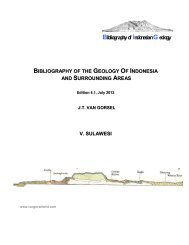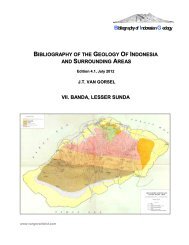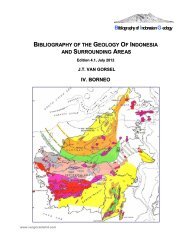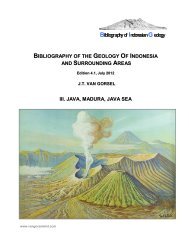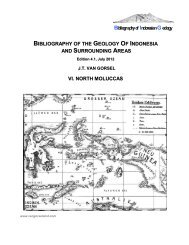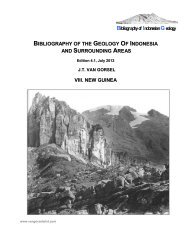Sumatra, Sunda Shelf, Natuna - Bibliography of Indonesia Geology
Sumatra, Sunda Shelf, Natuna - Bibliography of Indonesia Geology
Sumatra, Sunda Shelf, Natuna - Bibliography of Indonesia Geology
You also want an ePaper? Increase the reach of your titles
YUMPU automatically turns print PDFs into web optimized ePapers that Google loves.
Sitompul, N., Rudiyanto, A. Wirawan & Y. Zaim (1992)- Effects <strong>of</strong> sea level drops during Late Early Miocene<br />
to the reservoirs in South Palembang sub Basin, South <strong>Sumatra</strong>, <strong>Indonesia</strong>. Proc. 21st Ann. Conv. Indon. Petrol.<br />
Assoc. 1, p. 309-324.<br />
(Late Early Miocene sea level drops form sequence boundaries in late N6 and late N7. SB in Late N6 in Lower<br />
Talang Akar Fm, forming thick sand bodies which could be reservoirs. Late N7 sea level drop produced<br />
secondary porosity for carbonate reservoirs)<br />
Situmeang & P.R. Davies (1986)- A geochemical study <strong>of</strong> Asameras Block A Production Sharing Contract,<br />
North <strong>Sumatra</strong> Basin. Proc. 15th Ann. Conv. Indon. Petrol. Assoc., p. 321-340.<br />
(N <strong>Sumatra</strong> Block "A" with 11 commercial oil fields, which produced over 100 MBO, and one non-commercial<br />
gas field at Alur Siwah. In E part <strong>of</strong> block kerogen characterized by abundant land-derived organic material,<br />
while marine sapropelic organic matter increases to W, suggesting influx <strong>of</strong> land- derived organic matter from<br />
eastern land mass in area <strong>of</strong> Malacca Straits. Oils from Keutapang and Seureula Fm reservoirs <strong>of</strong> six different<br />
fields typically non-waxy, paraffinic, with 49.2° - 59°API gravities. Oils have common origin, probably fine<br />
grained marine sediments <strong>of</strong> M-L Miocene Baong Fm)<br />
Situmeang, S.P., C.W. Zeliff & R.A. Lorents (1992)- Characterization <strong>of</strong> low relief carbonate banks, Baturaja<br />
Formation, Ramba A and B pools, South <strong>Sumatra</strong>, <strong>Indonesia</strong>. In: C.T. Siemers et al. (eds.) Carbonate rocks and<br />
reservoirs <strong>of</strong> <strong>Indonesia</strong>: a core workshop. <strong>Indonesia</strong>n Petrol. Assoc., p 8.1 - 8.10.<br />
(Ramba Field produced 60 MBO oi1 1982-1992 from A and B pools, separated by paleochannel. Best reservoir<br />
rocks coral-rich packstones- wackestones, with 16-18% porosity)<br />
Situmorang, B., N.A. Harbury & M.G. Audley-Charles (1987)- Tectonic inversions in the <strong>Sunda</strong> Forearc:<br />
evidence from Simeulue. Proc. 16th Ann. Conv. Indon. Petrol. Assoc. 1, p. 57-63.<br />
(Cenozoic history <strong>of</strong> Simeulue, NW <strong>of</strong> Nias, includes Oligo-Miocene erosional unconformity. Repeated tectonic<br />
inversions may be related in part to transpression and transtension stresses generated by strike-slip motion<br />
interacting with sinuosities in trench and <strong>Sumatra</strong>n fault system)<br />
Situmorang, B. & Soepatono (1975)- Results <strong>of</strong> petroleum exploration in the interdeep basin <strong>of</strong>f West <strong>Sumatra</strong><br />
<strong>Indonesia</strong>. Proc. 12th Sess. CCOP, p. 255-262.<br />
Situmorang, B., S Wijaya, M. Husen & B. Yulihanto (1990)- Analisis struktur geologi Pulau Nias. Proc. 19th<br />
Ann. Conv. Indon. Assoc. Geol. (IAGI), 2, p. 27-41.<br />
('Analysis <strong>of</strong> the structure <strong>of</strong> Nias island')<br />
Situmorang, B. & B. Yulihanto (1985)- The role <strong>of</strong> strike slip faulting in structural development <strong>of</strong> the North<br />
<strong>Sumatra</strong> Basin. Proc. 14th Ann. Conv. Indon. Petrol. Assoc. 1, p. 21-38.<br />
(N <strong>Sumatra</strong> Basin development controlled by strike slip faulting. Several major N-S trending strike slip faults<br />
mainly with dextral movements formed in present back-arc region and arranged in en echelon pattern. Since<br />
then and until M Miocene, basin characterized by normal faulting. This episode corresponds to change in<br />
Indian Ocean spreading direction from N-S in E Paleogene to NE-SW. Convergence highly oblique in Late<br />
Miocene, producing compressive deformation and uplift. Compressional structures continuously affected<br />
sedimentary cover in Plio-Pleistocene due to strike slip faulting along <strong>Sumatra</strong>n Fault system)<br />
Situmorang, B. & B. Yulihanto (2007)- Formation <strong>of</strong> pull-apart basin along transcurrent fault: lesson from<br />
Sumatera. In: Geologi <strong>Indonesia</strong>: dinamika dan produknya, Geol. Res. Dev. Centre, Bandung, Spec. Publ. 33,1,<br />
p. 29-48.<br />
(Two prominent NW-SE transcurrent fault zones in <strong>Sumatra</strong>: Sumatera FZ parallel to the axis <strong>of</strong> the Barisan<br />
Mountains and Mentawai FZ along E slope <strong>of</strong> fore-arc ridge. N <strong>of</strong> Nias, MFZ and SFZ are linked by Batee<br />
Fault. Transtentional basins in back-arc (N, C, S <strong>Sumatra</strong>, Ombilin) and fore-arc (Singkel, Pini in NW, Bose,<br />
Sipora grabens in Mentawai area and Pagarjati, Kedurang in Bengkulu to SE).<br />
Situmorang, B., B. Yulihanto, A. Guntur, R. Himawan & G. J. Jacob (1991)- Structural development <strong>of</strong> the<br />
Ombilin basin, West <strong>Sumatra</strong>. Proc. 20st Ann. Conv. Indon. Petrol. Assoc.p. 1-15.<br />
<strong>Bibliography</strong> <strong>of</strong> <strong>Indonesia</strong> <strong>Geology</strong> v. 4.1 91 www.vangorselslist.com July 2012



